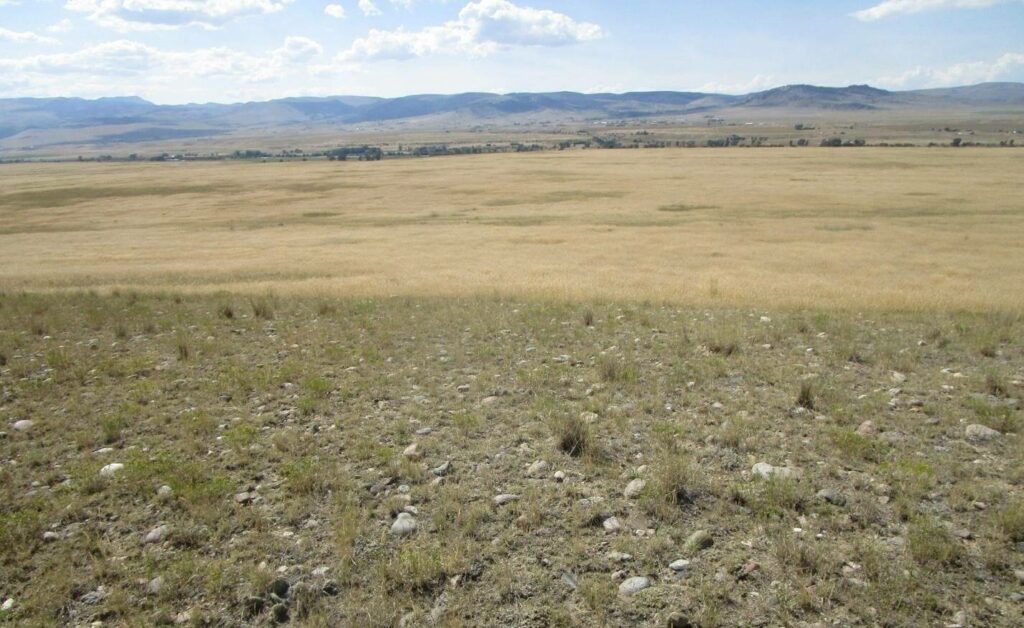Our previous article (MSC Quarterly, Fall 2016) emphasized that infestations of specific invasive and noxious plant species have increased soil erosion rates on tens of millions of acres in western states. This also results in losses of hundreds of millions of dollars in crop damage, habitat destruction, and control costs. Centurea maculosa (Cm, aka spotted knapweed) and Bromus tectorum (Bt, aka cheat grass) are examples of an herbaceous and a graminoid species that reduce soil stability by altering soil chemistry and plant community structures. Herbicides are one tool that can be safely used during the early stages of land rehabilitation. We will focus on four different active ingredients of the most popular herbicides used to control Cm and Bt. Aminopyralid- and picloram-based herbicide products are highly effective on Cm, while glyphosate- and imazapic-based products are often preferred for control of Bt. Once initial inventories and objectives are established, critical considerations regarding herbicide use for long-term revegetation objectives include: 1) Environmental restrictions; 2) Herbicide selection; 3) Conservation of competitive desirable plants; and 4) Herbicide persistence and seed mix design.
Environmental Restrictions – One or more pesticides (insecticides, herbicides, fungicides, etc.) were found in concentrations that exceed aquatic-life benchmarks in 61% of agricultural streams, 46% of mixed-use streams, and 90% of urban streams assessed between 2002-2011 (USGS, Stone, et. al., 2014). Applicators must understand aquatic toxicity, water solubility, soil adsorption, leaching and runoff potential, and product persistence. Aquatic toxicity is described as LC50, while human toxicity as LD50. Aminopyralid formulations are Category IV toxins (non-toxic); present very low risk to humans, mammals, fish, invertebrates; and are currently considered by the USEPA for approved use in water. Picloram, glyphosate, and imazapic formulations have LD50 > 5000mg/kg, and are Category III toxins (low toxicity). Aminopyralid is miscible (fully soluble), while picloram has low solubility (~400 ppm). Highly soluble products disperse rapidly in water. Adsorption (Kd/Koc) measures the mobility of an herbicide in soil. Herbicides with high Kd/Koc values are less likely to leach from soil and will preferably fix on clays and organic matter, but can mobilize during surface runoff as contaminated sediments. Glyphosate has a Kd/Koc of ~24000 ml/g, and is stable in soil. Picloram has a Kd/Koc of ~100ml/g, and is mobile in soil.
Herbicide Selection – Efficacy of modern herbicides is species specific. Aminopyralid and picloram are very effective on Cm and other Asteraceae (Sunflower family) species, but perform poorly on some Boraginaceae (Borage family) and Brassicaceae (Mustard family) species. Experienced applicators often combine different products with unique modes of action on target plants. Glyphosates are EPSP (amino acid) synthesis inhibitors. Aminopyralid and picloram, are synthethic auxins that inhibit plant cell growth, while imazapic products prevent protein synthesis.
Selective herbicides became widely available after WWII. They target forbs and are minimally deleterious to grasses. Most State and Federally listed “Noxious Weeds” are forbs. Aminopyralid, picloram, and imazapic are selective active ingredients that perform well through foliar or root absorption, and are systemic (translocate throughout the plant). They provide excellent control of a wide array of forb species. Excessive application rates of selective herbicides can kill most grasses and forbs, prevent revegetation for months or years, and result in increased soil erosion.
Non-selective herbicides are effective at killing most forbs, grasses, shrubs, and aquatic plants. Glyphosate is non-selective, is the most used herbicide globally, and was introduced in 1974. It must be applied onto emerged plant foliage, and offers little effect from absorption by roots. Glyphosate is a primary tool in control of shallow rooted Bt, and may be used repeatedly in a single year.
Sterilents offer long-term (1-3 yr./application) control of most plant growth forms and are non-selective. They are most often used as a pre-emergent technology on industrial facilities, utilities, and road right-of-ways. They are engineered to reside in the upper soil or substrate horizon, and prevent plant growth upward through the chemical barrier.
Plant Competition and Diversity – Retain species competition and diversity by conserving aggressive and resilient desirable forbs and grasses. Consider precision applications that preserve islands of robust and competitive desirable vegetation. Research clearly demonstrates that desirable forbs compete exceptionally well against undesirable forbs for required nutrients and water. Desirable forbs, as early seral species, often provide initial ground cover and resistance to re-establishment of invasive plants in herbicide treatment areas. Favorable forbs often provide superior fixation of atmospheric nitrogen, which enhances soil productivity. Once established, diverse plant community structure will better withstand future weed infestations, sustain healthy soil biota, and provide better wildlife habitat.
Herbicide Persistence – The physical property of herbicide persistence is often described as half-life (in soil), and is strongly influenced by soil chemistry. Consideration of persistence is paramount for successful revegetation. Selective herbicide residuum (and degraded by-products) can inhibit rapid establishment of forbs and, in some cases, may be adverse to grass germination. Herbicides can reduce soil microbe and invertebrate populations, reducing soil suitability for revegetation. Aminopyralid has a typical half-life of 30 days, and product labels recommend seeding of grasses and forbs 60 days after application. Picloram products can have a half-life of 100 to 300 days, during which time many forbs and some grasses may not successfully germinate. Glyphosate products are short lived in soil, and seeding can occur within 5 to 10 days after use. Proper seed mix design should consider ease of plant establishment, diversity of species and growth forms (forbs, graminoids, shrubs), plant resistance to re- infestation, and resilience to follow-up herbicide applications. Federal agencies require revegetation exclusively with native species. State agencies and private landowners can use non-native seed mixes for cover crops, erosion and sediment control, or forage production. Non-native grasses tend to re- establish more quickly than native grasses. In conclusion, proper use of herbicides during the initial phases of land rehabilitation can reduce risk of water resource contamination, improve control of target invasive species, allow for more rapid revegetation, reduce soil erosion, and reduce project costs.

John Whittingham, CPESC, PWS, IECA MSC Montana Representative Owner, Basic Biological Services LLC, Dillon, Montana (info@basicbiologicalservices.com)
